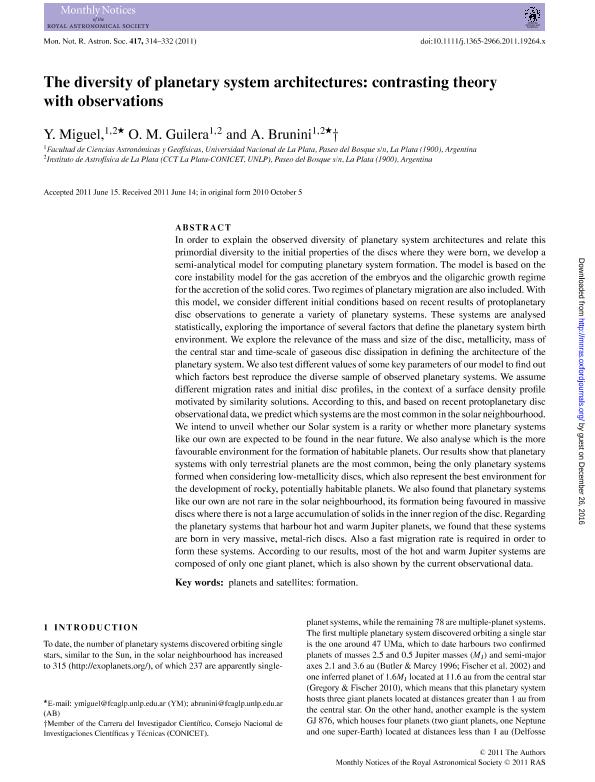Mostrar el registro sencillo del ítem
dc.contributor.author
Miguel, Yamila

dc.contributor.author
Guilera, Octavio Miguel

dc.contributor.author
Brunini, Adrian

dc.date.available
2016-12-26T14:09:33Z
dc.date.issued
2011-10
dc.identifier.citation
Miguel, Yamila; Guilera, Octavio Miguel; Brunini, Adrian; The diversity of planetary systems architectures: contrasting theory with observations; Royal Astronomical Society; Monthly Notices Of The Royal Astronomical Society; 417; 1; 10-2011; 314-332
dc.identifier.issn
0035-8711
dc.identifier.uri
http://hdl.handle.net/11336/10063
dc.description.abstract
In order to explain the observed diversity of planetary system architectures and relate this primordial diversity to the initial properties of the discs where they were born, we develop a semi-analytical model for computing planetary system formation. The model is based on the core instability model for the gas accretion of the embryos and the oligarchic growth regime for the accretion of the solid cores. Two regimes of planetary migration are also included. With this model, we consider different initial conditions based on recent results of protoplanetary disc observations to generate a variety of planetary systems. These systems are analysed statistically, exploring the importance of several factors that define the planetary system birth environment. We explore the relevance of the mass and size of the disc, metallicity, mass of the central star and time-scale of gaseous disc dissipation in defining the architecture of the planetary system. We also test different values of some key parameters of our model to find out which factors best reproduce the diverse sample of observed planetary systems. We assume different migration rates and initial disc profiles, in the context of a surface density profile motivated by similarity solutions. According to this, and based on recent protoplanetary disc observational data, we predict which systems are the most common in the solar neighbourhood. We intend to unveil whether our Solar system is a rarity or whether more planetary systems like our own are expected to be found in the near future. We also analyse which is the more favourable environment for the formation of habitable planets. Our results show that planetary systems with only terrestrial planets are the most common, being the only planetary systems formed when considering low-metallicity discs, which also represent the best environment for the development of rocky, potentially habitable planets. We also found that planetary systems like our own are not rare in the solar neighbourhood, its formation being favoured in massive discs where there is not a large accumulation of solids in the inner region of the disc. Regarding the planetary systems that harbour hot and warm Jupiter planets, we found that these systems are born in very massive, metal-rich discs. Also a fast migration rate is required in order to form these systems. According to our results, most of the hot and warm Jupiter systems are composed of only one giant planet, which is also shown by the current observational data.
dc.format
application/pdf
dc.language.iso
eng
dc.publisher
Royal Astronomical Society
dc.rights
info:eu-repo/semantics/openAccess
dc.rights.uri
https://creativecommons.org/licenses/by-nc-sa/2.5/ar/
dc.subject
Planets Formation
dc.subject
Solar System Formation
dc.subject
Satellites Formation
dc.subject.classification
Astronomía

dc.subject.classification
Ciencias Físicas

dc.subject.classification
CIENCIAS NATURALES Y EXACTAS

dc.title
The diversity of planetary systems architectures: contrasting theory with observations
dc.type
info:eu-repo/semantics/article
dc.type
info:ar-repo/semantics/artículo
dc.type
info:eu-repo/semantics/publishedVersion
dc.date.updated
2016-12-14T12:55:59Z
dc.journal.volume
417
dc.journal.number
1
dc.journal.pagination
314-332
dc.journal.pais
Reino Unido

dc.journal.ciudad
Londres
dc.description.fil
Fil: Miguel, Yamila. Consejo Nacional de Investigaciones Científicas y Técnicas. Centro Científico Tecnológico la Plata. Instituto de Astrofísica de la Plata; Argentina. Universidad Nacional de la Plata. Facultad de Ciencias Astronómicas y Geofísicas; Argentina
dc.description.fil
Fil: Guilera, Octavio Miguel. Universidad Nacional de la Plata. Facultad de Ciencias Astronómicas y Geofísicas; Argentina. Consejo Nacional de Investigaciones Científicas y Técnicas. Centro Científico Tecnológico La Plata. Instituto de Astrofísica de La Plata; Argentina
dc.description.fil
Fil: Brunini, Adrian. Universidad Nacional de la Plata. Facultad de Ciencias Astronómicas y Geofísicas; Argentina. Consejo Nacional de Investigaciones Científicas y Técnicas. Centro Científico Tecnológico La Plata. Instituto de Astrofísica de La Plata; Argentina
dc.journal.title
Monthly Notices Of The Royal Astronomical Society

dc.relation.alternativeid
info:eu-repo/semantics/altIdentifier/url/http://mnras.oxfordjournals.org/content/417/1/314
dc.relation.alternativeid
info:eu-repo/semantics/altIdentifier/doi/http://dx.doi.org/10.1111/j.1365-2966.2011.19264.x
Archivos asociados
